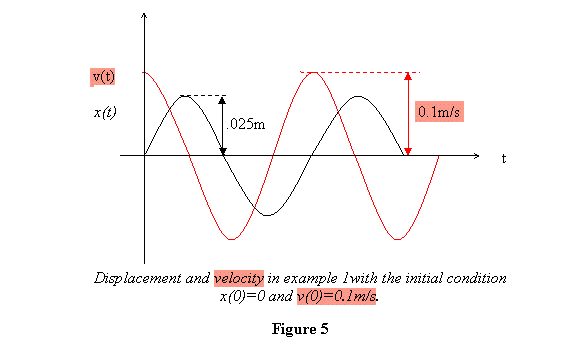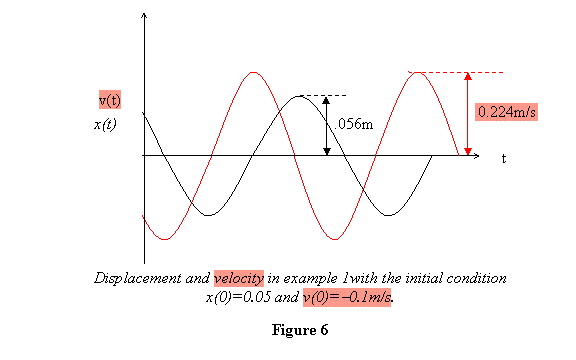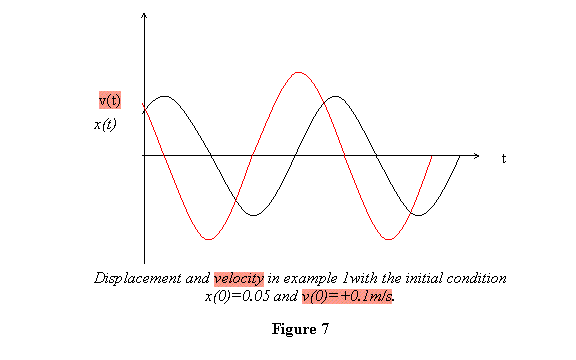Example 1: In a spring-mass system k
= 16 N/m and m = 1 kg .
If the mass is displaced by .05 m and
released from rest, find its subsequent motion.


Using the initial conditions I get
x(0)= D = 0 .05m

So the solution is  with
the maximum speed of 0.2m/s . The solution
x(t) is plotted in figure 4. Also plotted there
is the velocity v(t) of
the mass as it performs its motion. Notice that
from the x(t) curve, the velocity can be easily
plotted by taking its slope. with
the maximum speed of 0.2m/s . The solution
x(t) is plotted in figure 4. Also plotted there
is the velocity v(t) of
the mass as it performs its motion. Notice that
from the x(t) curve, the velocity can be easily
plotted by taking its slope.

Let me now show you how the solution changes when the
initial conditions are different. Suppose instead of
pulling the mass and releasing it, I give it an initial
velocity of .1m/s toward the right from the equilibrium.
In that case

So  .
Obviously the maximum speed in this case is 0.1m/s, that
given in the beginning. The solution looks like shown
in figure 5. .
Obviously the maximum speed in this case is 0.1m/s, that
given in the beginning. The solution looks like shown
in figure 5.

Third possibility of initial conditions is when I take
the mass to a displacement of .05m and push it towards
the equilibrium point with a speed of .1m/sec. Then

Thus the solution is  .
If we wish to express this as .
If we wish to express this as  then then

and

This gives  and and  .
The maximum speed in this case is vmax
= 4 x 0.056 = 0.224m/s .
So the graph of the motion looks like that shown
in figure 6. .
The maximum speed in this case is vmax
= 4 x 0.056 = 0.224m/s .
So the graph of the motion looks like that shown
in figure 6.

From the graph it is very clear that initially the speed
of the particle increases in the negative direction and
then the particle starts slowing down, stopping at the
full compression of the spring, as is clear from the
plot of its displacement.
If in the case studied just now, the mass was thrown out
instead of being pushed in, it would have a positive
velocity to start with but the speed would be decreasing
at that moment. Then the mass will travel out to its
maximum displacement and would then turn back. The general
plot of displacement and velocity versus time would then
look as in figure 7. I will leave it for you to work
out the numbers for amplitude and initial phase.

Example 2: In the second example
I show that about any stable equilibrium point, the
motion to a good degree is simple harmonic. let us
take two changes of 10 µC each
at a distance of half a meter so that is a positive
charge of 5 µC is kept
at the centre, its experiences no force (see figure
8). The 5 µC charge is
confined to move along the line joining the two
changes. If displaced by a small distance from
its equilibrium position, what kind of motion
does it perform?

When the 5 µC is displaced to the right
by x,
the force on it is

In obtaining the force above, we have used the binomial
theorem to expand  .
Since the force is proportional to the displacement and
in direction opposite to it, the charge will perform
simple harmonic motion. .
Since the force is proportional to the displacement and
in direction opposite to it, the charge will perform
simple harmonic motion.
Let me now look at some other examples, going beyond the
spring-mass system.
Example 3: A disc of mass M and
radius R is hanging on a will about
a point on its periphery (see figure 9). If it
is displaced from its initial position by small
angle  and
released, find its subsequent motion. and
released, find its subsequent motion.

This is a case where a rigid body is moving under distributed
forces so we use angular momentum to describe its motion.
The equation of its motion therefore is

By transformation theorem,

So the equation of motion becomes

This means that in general the motion of the disc would
be simple harmonic and will be given as

The initial conditions in this case give C = 0 and D
= θ0 . Therefore the solution
in the present case is  . .
Example 4: As the final example here,
let me take a particle moving in a potential  .The
potential has a minimum at x0 given
by .The
potential has a minimum at x0 given
by

You can yourself check that the second derivative at this
point is positive and its value is 8B. For
very small displacements x about this point
we have the change in the potential energy given as

which by binomial theorem or the Taylor series expansion
leads to

This gives an equivalent spring constant of k=8B and
frequency of oscillation  . .
Having solved these examples I now wish to discuss a very
important topic of phase and phase difference in a simple-harmonic
motion. I will spend some time discussion phasor diagrams
give a feel for the phase.
|